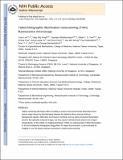Talbot holographic illumination nonscanning (THIN) fluorescence microscopy
Author(s)
Luo, Yuan; Singh, Vijay Raj; Bhattacharya, Dipanjan; Tsai, Jui-Chang; Yu, Sung-Liang; Chen, Hsi-Hsun; Wong, Jau-Min; Matsudaira, Paul; So, Peter T. C.; Barbastathis, George; Yew, Yan Seng Elijah; ... Show more Show less
Downloadnihms-657211.pdf (616.1Kb)
OPEN_ACCESS_POLICY
Open Access Policy
Creative Commons Attribution-Noncommercial-Share Alike
Terms of use
Metadata
Show full item recordAbstract
Optical sectioning techniques offer the ability to acquire three-dimensional information from various organ tissues by discriminating between the desired in-focus and out-of-focus (background) signals. Alternative techniques to confocal, such as active structured illumination, exist for fast optically sectioned images, but they require individual axial planes to be imaged consecutively. In this article, an imaging technique (THIN), by utilizing active Talbot illumination in 3D and multiplexed holographic Bragg filters for depth discrimination, is demonstrated for imaging in vivo 3D biopsy without mechanical or optical axial scanning. Optical sectioning techniques offer the ability to acquire three-dimensional images by discriminating the desired in-focus signal from out-of-focus (background) signals. Alternative existing techniques require scanning laterally or imaging individual axial planes consecutively. Here, an imaging technique (THIN), by utilizing the active illumination and multiplexed volume holographic collection, is demonstrated to image in vivo 3D biopsy without any scanning. © 2014 by WILEY-VCH Verlag GmbH & Co. KGaA, Weinheim.
Date issued
2014-08Department
Massachusetts Institute of Technology. Department of Biological Engineering; Massachusetts Institute of Technology. Department of Mechanical EngineeringJournal
Laser & Photonics Reviews
Publisher
Wiley
Citation
Luo, Yuan, et al. “Talbot Holographic Illumination Nonscanning (THIN) Fluorescence Microscopy: Talbot Holographic Illumination Nonscanning (THIN) Fluorescence Microscopy.” Laser & Photonics Reviews, vol. 8, no. 5, Sept. 2014, pp. L71–75.
Version: Author's final manuscript
ISSN
1863-8880